o_19po8js951tvs1r0t1r8s4bb1vpla.pdf
Create successful ePaper yourself
Turn your PDF publications into a flip-book with our unique Google optimized e-Paper software.
Introduction<br />
It is with a great pleasure that we offer to the reference community in design<br />
another edition of the Advanced Studies in Design Notebook with the title Design<br />
and Humanism. These texts were part of the presentation of the writers present<br />
here, as Keynote Speakers and/or organizers of the 4 th International Forum of Design<br />
as a Process, thematic-scientifical meeting of the Latin America Network for the<br />
Development of Design, held in Belo Horizonte, in 2012.<br />
The intention of the Scientific Committee of the Forum was to make visible<br />
issues related to human and social disciplines and, likewise, their interfaces and<br />
connections with the world of design activity. We sought to provide a reflection on<br />
the contribution of the disciplines of humanistic scope and nature to the culture of<br />
the project and the constant “contamination” positive and evolutionary arising out<br />
of this relationship. Over the articles, now presented in book form, faced with intense<br />
reflections on contemporary design, its challenges and opportunities and influence<br />
for the future activity.<br />
For Deborah Philips, contemporary theme park has been read as the materialization<br />
of the post-modern site, and the use of collage, juxtaposing narratives and images, is<br />
often invoked as a lasting feature of postmodernity. However, the animator loan and<br />
reproduction of cultural narratives and images “inherited” may not be a uniquely<br />
postmodern phenomenon. While new reproductive technologies and global culture<br />
increased the speed and scope of a shared cultural iconography, repeated reproduction<br />
of familiar stories and images is not a postmodern phenomenon or even a modern<br />
phenomenon, but a process that dates from the beginning of reproduction of visual<br />
culture.<br />
Flaviano Celaschi and Dijon De Moraes gathered to reflect on the future of design<br />
and its connection with the humanists and social areas. The authors put the design in<br />
a dubious dilemma between rational model-functionalist, with eminently technicist<br />
and linear emphasis, and its interface with the humanistic disciplines hitherto with a<br />
little recognition within the technological culture and consequently the culture of the<br />
project. The guidelines: FUTURE, WELL-Being and INTERDEPENDENCE demonstrate<br />
extreme consistency between design and the social scope and thus between the design<br />
and the humanities, seeking to show that these words can be a synthesis of social<br />
references applied to the design. It is in this context that the humanistic disciplines<br />
14



